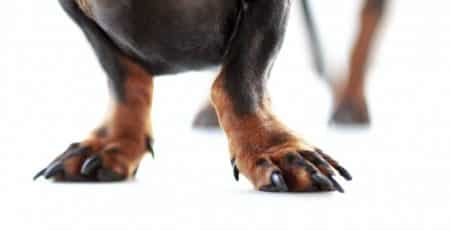Does my dog have a stone in its bladder?
Being a veterinary student, I had the privilege to shadow a veterinarian in my home town this summer. In a clinic one gets to observe a lot of interesting cases. I was surprised to see a large number of urolith cases; not a week went by without seeing a number of patients suffering from such problems. Uroliths are more commonly known as kidney and bladder stones. Dog owners are often surprised when they hear the news that a stone the size of a ping pong ball suddenly appeared in their dog’s bladder! Removing them once, in some cases, does not solve the problem permanently, and their coming and going can be a real pain … like literally.
How do I know if my dog has a urolith?
Is your dog struggling to urinate? Are there any traces of blood in your dog’s urine? Answering these two questions with a “yes” does not necessarily mean that a dog has a urolith lodged in it’s bladder. However, answering these questions provides you with a clear indication of whether something is wrong. Whether it is a urolith, a tumor, a polyp or just a urinary infection is not for the owner to decide. The dog must be taken to a veterinary clinic where the necessary examinations could be done. It is always promising if the dog is still able to urinate but if this is not the case, it is imperative that the dog is rushed to the nearest veterinary surgery in order to avoid the possibility of a bladder rupture.
Some stones are large enough to be palpated by hand through the dog’s abdominal wall. Whether or not one can feel the stones by hand, other techniques such as X-ray radiography, and ultrasonography, must be used in order to determine the size, shape, location, and number of the stones lodged within the dog’s urinary system. Depending on the quality, size, and location of the stones, the method of treatment can finally be determined. Treatment can range from changing the dog’s diet and coming back for a follow up examination to check for any progress, or resorting to more invasive techniques such as surgery.
What kind of bladder stones can form in my dog’s urinary system?
Uroliths come in all shapes, forms and sizes. You might be surprised by what might get lodged in your poor dog’s bladder. Struvite uroliths are the most common culprits for such urinary problems. However, there are other kinds of uroliths made up of calcium oxalate, urate, and cystine. It is also common for bladder stones made of different layers of the above materials to be formed.
Struvite forms 50 to 90% of all uroliths. Struvite stones are usually made out of magnesium ammonium phosphate and usually form when the dog’s urine becomes slightly alkaline. This usually happens because of urinary tract bacterial infections that possess urease enzyme. This enzyme breaks down urea turning the urine alkaline, and causing damage to the bladder wall. This forms a focal point around which struvite can precipitate forming a stone. Struvite uroliths occur more commonly in female dogs.
Calcium Oxalate uroliths occurs in only 30% of all urolith cases. However, Calcium Oxalate crystals are becoming increasingly more common. Calcium oxalate crystals are formed in acidic conditions when there is higher levels of Calcium and Oxalate ions then normal. The lack of citrate in urine to keep both ions in solution also contributes to oxalate urolith precipitation. This form of urolith occurs more commonly in male dogs.
If you own a dalmatian or a dog that suffers from portosystemic shunt, you might want to take special care that no urate stones are forming in your pet’s urinary system. The metabolic urate in these dogs is not efficiently converted to allantoin, a metabolite that can be excreted safely in urine. This results in high levels of urate and ammonium in the dog’s urine, which can lead to the formation of urate stones.
Dogs with kidney amino acid resorption problems often suffer from the formation cystine stones. In normal, healthy dogs, 97% of all cystine that finds itself in urine is usually reabsorbed by the kidney. However, in these dogs cystine is not reabsorbed and, being a relatively insoluble amino acid, precipitates to form a urolith in the dog’s urinary system.
Are uroliths preventable? What can be done to get rid of existing ones?
Yes, dog owners can help with the prevention and the dissolution of uroliths. When dogs suffer from the above uroliths, the general rule is to feed low protein diets and encouraging their dogs to drink more water.
It is possible to dissolve Struvite, Urate, and Cystine stones by managing feed and water intake to reduce the substrates necessary for the formation of these stones and also maintaining the necessary urine acidity, or alkalinity in order to avoid the formation of these uroliths. Cases suffering from cysteine and urate stones benefit from turning urine alkaline. This can usually be achieved through rigorous dietary management. Some enzyme inhibitors and feed additives that turn urine alkaline can also be given in order to prevent the formation or dissolve these stones. On the other hand, an acidic environment prevents the growth of struvite stones by inhibiting the growth of urease producing bacteria. Low protein, low magnesium, and low phosphate diets will also starve the struvite deposition process from the substrates necessary for the formation of these stones, and promote the dissolution of any existing ones. Calcium Oxalate stones often need to be removed surgically due to their resistance to any efforts to dissolve them. If dissolution efforts are not effective, the dog might unfortunately need to go under the knife, for the uroliths to be removed surgically.
Increased water intake and renal clearance in Struvite and Urate stones, is often achieved by feeding a salt rich diet. However, feeding a salt rich diet is detrimental for the prevention of Calcium Oxalate stones and the dissolution of Cystine stones. Potassium citrate is often used as a substitute to sodium bicarbonate in order to achieve alkaline urine in the case of Cystine stones.
Calcium Oxalate uroliths are often managed depending on the root of the problem. If the problem is due to high calcium intestinal absorption, a calcium restricted diet needs to be fed. If the problem is hormonal, the priority is to solve the endocrine problem while helping out by feeding a calcium restricted diet. However, there are times when the kidney has a problem leading to excessive calcium loss; this condition is not understood very well and therefore still is very difficult to tackle. Feeding a diet low in oxalic acid, and maintaining neutral urine acidity usually helps with the prevention of oxalate uroliths.
Never attempt to tackle such health issues of your own. Uroliths are a very serious matter and require the immediate attention of a qualified Veterinarian. Veterinarians have the necessary training and equipment to guide you towards what’s in the best interest of your dog.






















